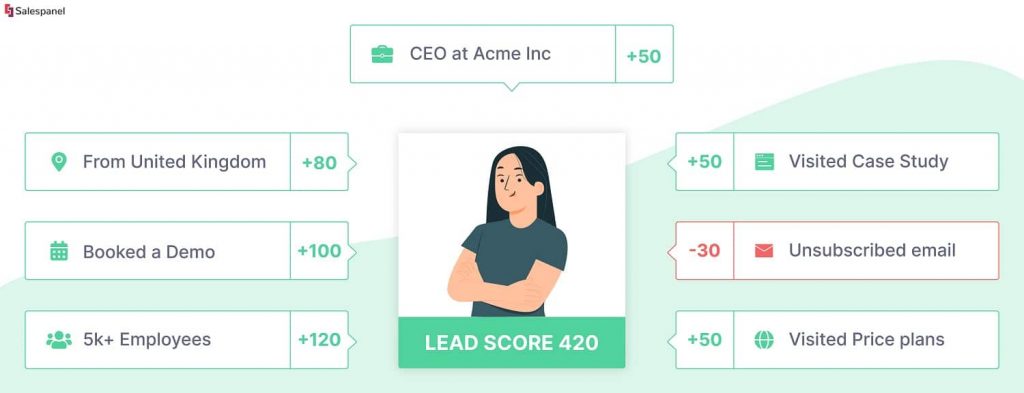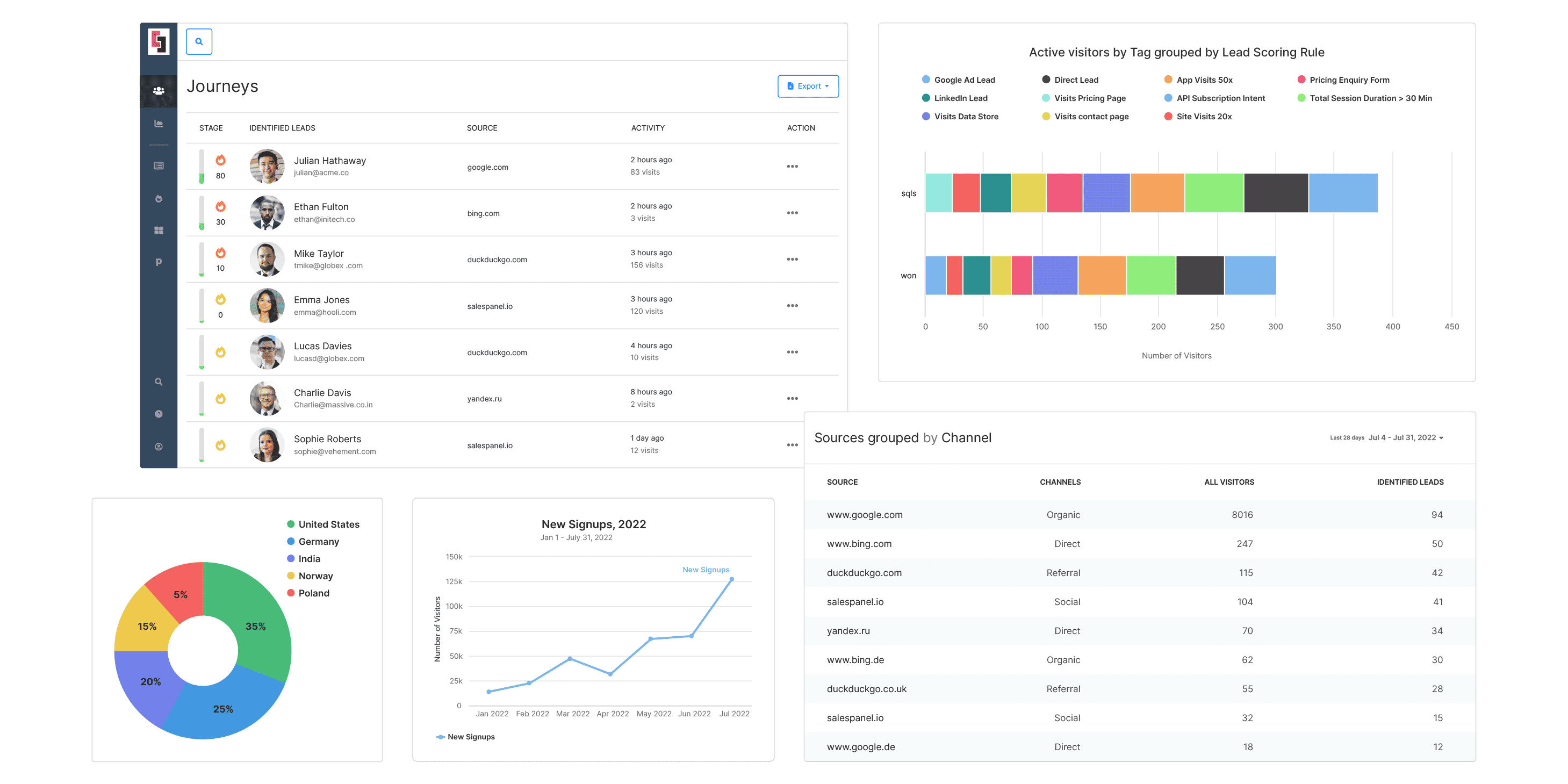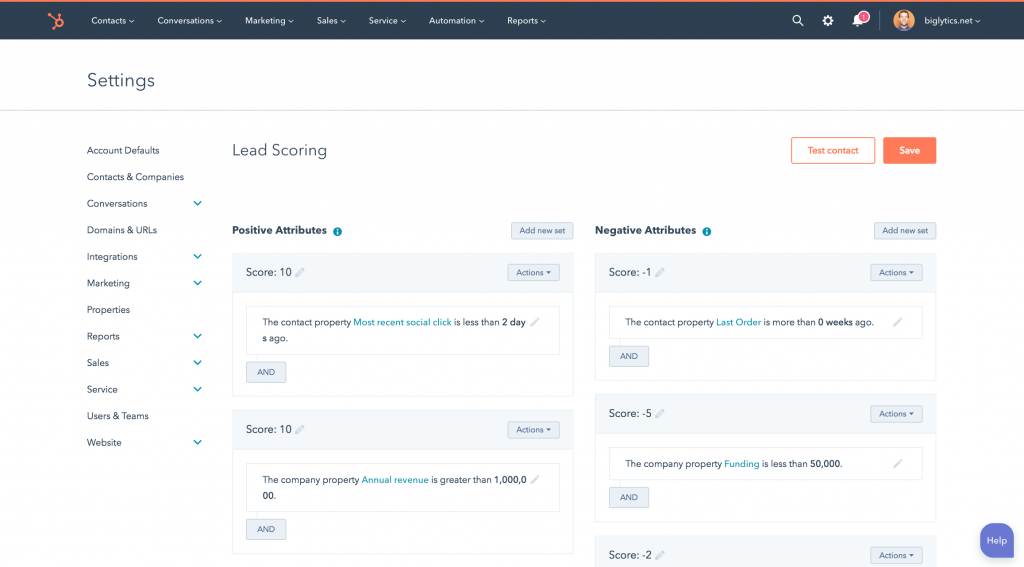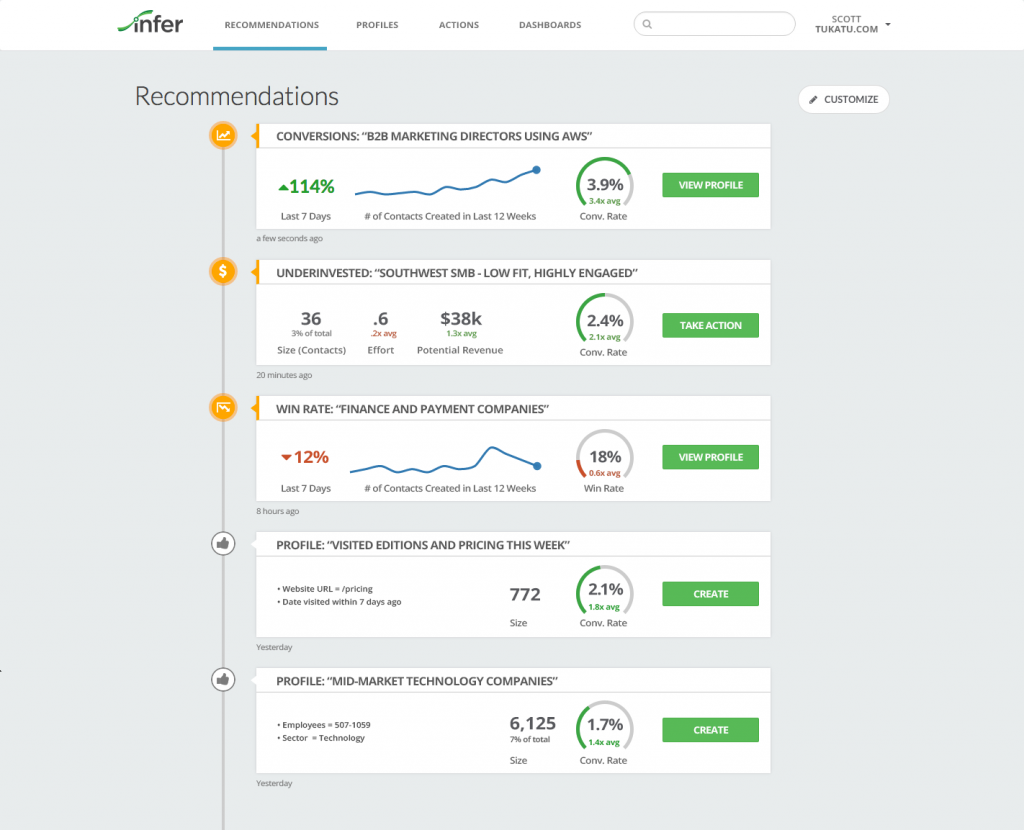Best Lead Scoring Models and Tools to Qualify Leads
Lead scoring is a methodology to rank leads against a scale (usually 0-100) in numerical values. A lead scoring model is used to tailor-fit this methodology for your product or service. It is supposed to ensure that the higher a lead is scored the more likely he/she/they are to buy your product.
In this article, we will break down lead scoring, and understand why you should and shouldn’t use it, and how you can set up a B2B lead scoring model for your business.

Who is Lead Scoring Suitable For?
Before we begin, it is important to determine first if lead scoring is suitable for your business. Depending on how your business operates and the volume of leads you generate every month, the implementation of lead scoring can range anywhere from an absolute game-changer to absolutely unuseful.
If your business generates a high amount of leads and your resources are constrained by it, you need lead scoring. If you are a product company, you need lead scoring. If your sales reps have to frequently tackle bad leads, you need lead scoring. Even if you have a medium volume or need the most optimal usage of your resources, lead scoring can be good for you.
On the contrary, if you have a very small volume of leads or have very hight ticket prices and a workflow where all leads are treated with care, lead scoring might not be of help. It can still help you prioritize the best ones but that’s about it. Now that is out of the way, let’s dive deeper.
Lead Scoring 101
Lead scoring is a qualification strategy where leads are gradually qualified as they engage with your funnel. They are typically scored in the numerical range of 0 to 100 but that is not set in stone. You can use any range of your choice. Initially, leads get scored based on their individual, demographic, and firmographic characteristics. Later they would progressively get scored based on their behavior. Let’s take an example. You have a lead scoring model set up and you have several rules in place. Leads who visit from a buyer keyword on Google Ads (Let’s say ‘XYZ’) show high intent and get 40 points to start off. Leads get 20 points if they are from an account sized between 50-200 and get 30 points if they are from your region (let’s say California). So, when a lead visiting your website with all of these characteristics would get 90 points (40+20+20) immediately. They would then gradually be scored based on their activities. Pricing page views, scheduling a demo, filling out a form, reading a case study, or watching webinars can all be used to award points. When a lead crosses a minimum point threshold, they are considered qualified. This is the general concept behind lead scoring.
And, not just positive points, leads can also have points deducted for unfavorable characteristics and behaviors. Belonging to an industry you don’t serve, unsubscribing to something, or bouncing fast can all be considered for negative scoring. At the end of the day, the points add and deduct and you reach the final score.
What are Lead Scoring Models? Understanding Data Points
A lead scoring model is a workflow or a system you create/use to score your leads. This model can be specifically created for your business manually or can be automatically provided by the lead scoring technology you use. A lead scoring model would use data points and add points to each criterion. At the end of the day, the net score would be used to prioritize and determine the quality of leads.
Lead scoring systems solve two critical problems: cleaning and aggregating behavioral and profile data and applying this data as input to a model which can score a lead. The outcome can still be poor if the lead scoring model can’t utilize all the available data. The system must be capable of harnessing the power of all available data.
This brings us to important things about lead scoring models you wish you had known before you started.
Lead scoring has become an important part of the marketing tool stack, and it’s needed to accelerate your revenue pipeline. It filters qualified leads and provides invaluable insights. A scoring system can highlight ‘things to be noticed’ and help it rank higher in the pipeline.
A common question we get is – wait, we can get that done from segmentation. Yes, but Segments work better in cases where:
- You have multiple criteria that fit together to define a specific cohort. These qualifiers fall in the known-known case.
- You can set up triggers and notice surges in these cohorts. They are well-defined parts of your audience.
But Segments never get into the individual qualifications of a lead. So, for example, a lead can qualify for multiple segments but what exact qualifications make them SQLs is still hard to determine.
Whereas scoring can look at individual positive profile attributes and behaviors one at a time and even catch a qualified lead with attributes that were not part of originally defined segments, the unknown-unknown case.
So let’s have an example. A lead is qualified if:
- A person is from a specific country
- Downloads a case study.
- Visits the pricing page for more than 30 seconds.
If you combine all of these rules, you get one segment, but with individual rules which can work independently, you can have many permutations and combinations of leads qualifying for some or all criteria. Lead scores can be used with segmentations making the workflow even more efficient.
Now let’s jump to predictive and point-based models. The point-based system can be on a 100 (percentile-based) scale or score based on your own custom scale of numbers.
Onboarding for predictive scoring models is complex because you will have to ensure that you have all the data for training the model. The model will be as good as your training data, and the efficiency will depend on the mathematical algorithm. All challenges that are applicable to machine learning models also apply to these models. For example, you might need to keep adjusting your model to make sure it’s precise, not too broad, and responds to ever-changing data.
Predictive models also have a minimum requirement of data volumes because mathematical models cannot be trained without enough data. Predictive models can be black-box and white-box. Sounds interesting, yes? So white-box means they will tell you why they think a lead is a good lead, but a black-box model is only capable of predicting/labeling a lead; they can’t reveal the decision tree!
A point-based system is simple but can be as powerful as predictive models. Point-based models are easy to onboard. You can install your insights into point-based rules having a certain weightage. Your data can be analyzed to find out important scoring conditions with appropriate weights. The most significant benefit of these systems is they can work in real time, which means they can even score visitors in real-time (sounds cool? Check out Salespanel). Point-based scoring systems need very low maintenance and are always white-box models. So if you don’t want to get into data science yet want a very efficient system that can score leads and visitors, that’s what you are looking for.
All scoring systems have at least two aspects: profile fit and behavior fit. Let’s take an elementary example. Let’s say a lead is detected on your website from an enterprise company, profile fit will say it’s a qualified lead, but their behavior on your website can tell a different story because the person might be going to your careers page and might be a job seeker. So no matter what kind of scoring model you are using, you would have these two dimensions.
Scoring systems are not perfect, and they inherit human biases, so they need constant feedback. For example, if you have a criterion that applies to SQL but most WON leads are not showing that criteria, your model probably needs tweaking. Another example is if your training data set had noise, low ticket size deals can train the model to ignore high ticket qualified leads (outliers).
Let’s have a look at all the data points that are available at the disposal of B2B businesses.
1. Account data
In B2B, you sell to individuals, yes, but you actually sell to businesses they work for. So, your customer is actually the account. For this reason, account information is the most crucial data point for scoring leads. Your ideal customer profile will consist of specific account types. For businesses selling to small startups, their target accounts would have less than 50 employees. For businesses selling to large businesses, their target accounts would ideally have more than 500 employees. Similarly, your target customer profile would also contain specific industries, funding/revenue stages, and other characteristics. All of these can be used to score leads based on account data.
2. Individual data
A business buys from you. But, there are several people in the company who would be facilitating the purchase. Oftentimes, there would be only one key decision-maker. This person will introduce your product to his/her company and he/she is probably the primary source of contact and has signed up. This individual’s data points are used to qualify the lead. The most commonly used individual qualifier in B2B is Job Title. The job title is a key indicator to determine if the lead has decision-making capabilities in the company. Other attributes like department and seniority level/work duration can also be used for lead qualification.
3. Demographic data
Demographic data comprises of population-based factors. This includes country, city, state, gender, age, marital status, etc. While most of these data points are not necessary for B2B lead qualification, data points like continent or country are crucial if your business operates in specific locations or if buyers from a particular region are more likely to pay more. Leads from target locations are given positive points while those from locations where you don’t want to serve are given negative scores.
4. Behavioral data
This is where lead scoring shines. As leads proceed through the customer journey, they would take actions that would give you serious indicators of buying intent. For example, if a lead continues to navigate your product or services or signs up after checking out your pricing page, it gives a strong hint that the lead is comfortable with your pricing model. A lead researching about a particular use case would indicate to you that the lead is interested in that use case. Your website is a weapon that you have complete control over. And, every part of this weapon can be used to determine the quality of your leads. Page views, visit durations, button clicks, content consumption (like viewing a video or reading a case study), activity level, product usage, email activity, live chat activity, etc. are all key behavioral data points that can be used to score leads.
5. Campaign and Source Data
While a subset of behavioral data, this dataset needs a dedicated discussion of its own. Where your leads come from can be a crucial indicator of intent. For example, if you are running ads on high buyer intent keywords, leads visiting from those keywords are more likely to buy than those who checked your product out after finding a knowledge piece from your blog on the SERPs. Sure, those Top of the Funnel (TOFU) leads can still convert but that’s another story. Taking a look at historical data of previously converted leads would give you a good idea about campaigns and channels that bring more revenue. This information can be used to qualify leads.
Examples of lead scoring models
We have pretty much covered everything you need to know about lead scoring models. Let’s take a look at a few examples of scoring models that can help you get started.
1. A SaaS product
Let’s think of a SaaS product. This product has a freemium pricing model and receives hundreds of sign-ups every day. But, only a small fraction of those signed up users end up subscribing to a high ticket plan. Allocating sales resources is a problem for this company which is why they have deployed a lead scoring model. Here’s what the model looks like:
- Award 10 points if the user is from a high converting locations ( US and UK)
- Award 40 points if the user is a decision maker
- Award 70 points if a user picked Growth and above plan during free trial.
- Award 30 points if company size is between 50-200.
- Award 30 points if total usage is more than 100 minutes.
- Deduct 50 points if total usage is less than 10 minutes.
- Award 50 points if an integration is activated.
- Award 30 points if team members have been added.
- Award 100 points if user is close to crossing product limits (custom event)
- Deduct 40 points if user goes cold for more than 7 days
The company would also set up a qualification threshold (let’s say 100 points). Once a lead crosses 75 points, they are automatically routed to sales reps who would initiate conversations with them.
2. Small online business selling to high ticket leads
This business works with lower volumes but the leads who are qualified often are high ticket. While having lower volumes, they still have a requirement to prioritize leads. So, here’s how they would set up their model:
- Award 20 points if lead visits XYZ page on the website. (This page is really important for them).
- Award 20 points if lead visited quotation page.
- Award 40 points if lead fills up enquiry form.
- Deduct 40 points if lead bounces after first visit.
- Award 20 points if lead returns to website from retargeting ads.
- Award 20 points if lead visits from buyer keywords through Google Ads.
- Deduct 30 points if lead unsubscribes to email communication.
Leads here will be graded based on the points they acquire. The more points they have, the higher priority they will get in the queue.
These two examples would give you some ideas on how lead scoring models can be set up. A rule-based scoring tool would give you the opportunity to set this up for yourself. This is ideal for most SMBs and Mid-markets who want to get into lead scoring. A predictive scoring tool, on the other hand, would automatically score your leads by creating profile-fit and behavioral-fit models based on historical conversion data and analysis. This is ideal for large enterprises who have more volume of data to work with.
Now, let’s talk about some of these tools and how they can help you get started.
Tools to create lead scoring models
Salespanel

Salespanel is a behavioral-fit focused scoring solution that helps you gradually qualify leads based on first-party data. When leads enter your funnel and visit your website, tracking of their activities starts immediately. The tool will log the source of the visit (UTM parameters and advert tracking templates), and keep tracking the activities until the lead identification eventually happens. When a lead provides their contact information through forms, live chat or the calendar widget on your website, both past activities and current activities would be stitched together. The tool will also enrich this contact with firmographic and demographic information (role, company, industry, etc.). All of these data points are available for you to create your model.
The tool also helps you track specific lead activities like custom conversion events, video views, button clicks, or any other unique action that is important for your business and use it for lead scoring. Essentially anything that happens on your website can be utilized for lead scoring.
While the product focuses on helping you create your own lead scoring model, a predictive system also comes out of the box to automatically score your leads. The lead scores can also be synced to your CRM in real-time.
Lead scoring works best for identified leads. However, anonymous visitors and B2B accounts that are detected from your website can also be scored for retargeting, website personalization, message triggers, lookalike audience creation, and other purposes. Talk to us and you can get started with lead scoring in $249/month.
Hubspot
Hubspot is the jack of all trades when it comes to marketing and sales tech. Dharmesh Shah, co-founder of Hubspot, once said that while it is common consensus to find one thing and do it right, they decided to do the exact opposite – do everything. So, you will find lead scoring in Hubspot, primarily in their Marketing Hub tool.
Hubspot offers both predictive and rule-based lead scoring offerings. Your model is more effective if you use other tools provided by Hubspot i.e their forms, live chat, email marketing tool, etc. Leads can be scored based on contact field data (role, company size, industry), website activity, email activity, and campaign data.
Rule-based scoring is available on Marketing Hub Professional (starting at $890/m) and Marketing Hub Enterprise (starting at $3200/m) and predictive scoring is available in both Marketing Hub Enterprise (starting at $3200/m) and Sales Hub Enterprise (starting at $1,200/m) plans.

Infer
Infer is a predictive lead scoring solution that uses AI and machine learning to score your leads and accounts. The workflow is pretty simple. Infer will study your existing customers and data points and understand the key traits. It will then use its predictive modeling to show you leads who are more likely to buy. These leads can then be prioritized or passed on to sales reps in an efficient manner. Infer is good for a large enterprise with a high volume of sophisticated data.
Pricing of the product is not known but you can expect it to be in the upper range.

Key Takeaways and Closing Thoughts
If your business sells online and would benefit from prioritizing or qualifying potential customers, lead scoring is a good option to help you achieve that. Here are your key takeaways from the article:
- A lead scoring model is a system that can deployed to rank leads on a scale of numerical values to prioritize customers who are more likely to buy.
- A lead scoring model heavily relies on data to work. Lead scoring models rely on either profile-fit or behavioral-fit or both.
- Lead scoring shines more in a behavioral-fit model or a predictive model as a profile-fit model can also be implemented with segmentation.
- Lead scoring tools are either rule-based (where you create rules manually) or predictive (automatic) or use a hybrid model.
- Tools like Salespanel, Hubspot, and Infer can help you get started with lead scoring.
Sell more, understand your customers’ journey for free!
Sales and Marketing teams spend millions of dollars to bring visitors to your website. But do you track your customer’s journey? Do you know who buys and why?
Around 8% of your website traffic will sign up on your lead forms. What happens to the other 92% of your traffic? Can you identify your visiting accounts? Can you engage and retarget your qualified visitors even if they are not identified?


